英语文学作品中的修辞手法运用.docx
英语中常见的修辞手法(范文)
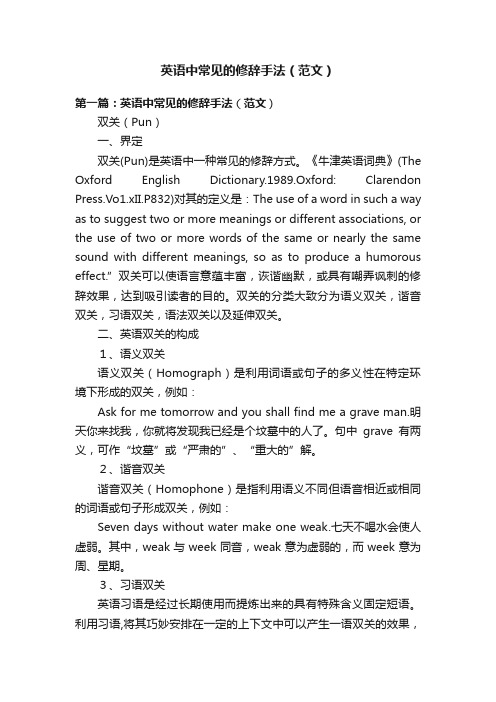
英语中常见的修辞手法(范文)第一篇:英语中常见的修辞手法(范文)双关(Pun)一、界定双关(Pun)是英语中一种常见的修辞方式。
《牛津英语词典》(The Oxford English Dictionary.1989.Oxford: Clarendon Press.Vo1.xII.P832)对其的定义是:The use of a word in such a way as to suggest two or more meanings or different associations, or the use of two or more words of the same or nearly the same sound with different meanings, so as to produce a humorous effect.”双关可以使语言意蕴丰富,诙谐幽默,或具有嘲弄讽刺的修辞效果,达到吸引读者的目的。
双关的分类大致分为语义双关,谐音双关,习语双关,语法双关以及延伸双关。
二、英语双关的构成1、语义双关语义双关(Homograph)是利用词语或句子的多义性在特定环境下形成的双关,例如:Ask for me tomorrow and you shall find me a grave man.明天你来找我,你就将发现我已经是个坟墓中的人了。
句中grave有两义,可作“坟墓”或“严肃的”、“重大的”解。
2、谐音双关谐音双关(Homophone)是指利用语义不同但语音相近或相同的词语或句子形成双关,例如:Seven days without water make one weak.七天不喝水会使人虚弱。
其中,weak与week同音,weak意为虚弱的,而week意为周、星期。
3、习语双关英语习语是经过长期使用而提炼出来的具有特殊含义固定短语。
利用习语,将其巧妙安排在一定的上下文中可以产生一语双关的效果,例如:---Why is fly one of the grocer’s best customers?---When one comes in for sugar, he always settles on the spot.on the spot 这一习语/当场、立即。
英语写作中的修辞手法与表达技巧

英语写作中的修辞手法与表达技巧写作是一门艺术,无论是中文还是英文写作,修辞手法和表达技巧都是至关重要的。
而英语作为一门全球通用的语言,更加注重准确、优雅的表达方式。
本文将重点探讨英语写作中常用的修辞手法和表达技巧,以帮助读者提高英文写作水平。
一、比喻与隐喻比喻和隐喻是英语写作中最常用的修辞手法之一。
比喻是通过将一个事物与另一个事物做类比来帮助读者更好地理解。
例如,“她的笑容如春日的阳光般温暖。
”这个比喻将她的笑容与春日的阳光做类比,形容其温暖的特质。
隐喻则是通过象征性的语言来传达某种含义。
例如,“他是我的明灯,指引着我前进的道路。
”这个隐喻将他比喻为明灯,表示他在作者的生活中扮演着重要的角色。
二、对比与排比对比和排比是一种常用于英语写作的修辞手法,可以帮助加深读者对比较对象之间的差异或相似之处,并以此达到强调的效果。
例如,“她的眼睛像黑夜的星空,他的眼睛却如湖水般清澈。
”这个对比通过描绘两个人眼睛的不同特点,突显了他们的个性差异。
排比则是通过反复使用相同的句式结构来强调同类事物的重要性。
例如,“We learn history not by textbooks alone, but by the stories of those who came before us; We understand the world not just through our own eyes, but by stepping intothe shoes of others.”这个排比通过强调多种途径了解历史和理解世界的重要性,为读者展示了更加全面的思考方式。
三、使用修辞词汇使用修辞词汇可以使文章更加生动有趣,增强语言的表达力。
例如,用形容词来修饰名词,用动词来描述动作,用副词来修饰动词等。
例如,“The delicate petals of the rose danced in the breeze.”这个例子中,使用了“delicate”来修饰“petals”,使读者能够更加直观地感受到玫瑰花的美丽。
老人与海英文版修辞手法

《老人与海》英文版的修辞手法主要包括以下几种:
比喻手法:这是小说的一大亮点,也是具有代表性的语言特色。
作者在描写人物、景物和鱼类时,大量地运用比喻手法,这些比喻手法的使用,充分展示了其精湛的修辞艺术和独特的写作技巧。
重复手法:作品中重复的或者是稍加变化重新应用的句子比较多,一方面使整体的创作文笔更加流畅,充满神秘色彩;另一方面也强化了感情和语气,突出了表现效果。
自由直接引语:现代小说主要是通过“第三人称”的心理活动达到再现生活的目的,作者在创作过程中,在表现思想的潜意识性和随意性时,多采用自由间接思想和自由直接思想。
在《老人与海》这部小说作品中,便是充分应用了自由直接思想,据初步统计,大约出现了150次左右,同时也成为了其一大语言特色,值得后世读者对其象征意义和语言特色进行深入挖掘和体会。
省略结构:巧妙运用省略句使《老人与海》的语言更生动活泼,收到言简意赅的强烈效果。
例如:以“Not”一词开头,充分表达了老人此刻的内心活动。
综上所述,《老人与海》英文版通过运用多种修辞手法,成功地增强了语言的表达效果,使读者更加深入地理解了作品的内涵和人物性格。
英语文学作品中修辞手法的应用探析

英语文学作品中修辞手法的应用探析英语文学作品对于大多数人来说,是一种艺术的魅力,其中的修辞让读者有一种亲近的感觉,使作品更具有感染力和吸引力。
修辞被定义为语言的艺术手法,通过增加文学作品的节奏、意象、冲击等特点,增加文学作品的艺术性、准确性和引人注目性。
英语文学作品中的修辞手法是语言表达艺术的重要组成部分,也是语言表达艺术实现者对文学思维内容的表达重要的手段。
本文旨在探讨英语文学作品中修辞手法的应用,指出修辞的种类,以及它们在作品中的运用情况,从而可以帮助读者从一个更深层次上理解作品的含义。
修辞手法是文学作品中语言手法的种类,可以划分为形式修辞和意义修辞,前者广泛应用于文学作品中,后者则是作品中更加抽象的表达形式,深刻地反映了故事情节。
形式修辞主要分为比喻、排比、拟人、借代、照应、反复,主要用于增强情绪效果,进一步深化读者对作品的理解。
比喻是比较两个不同的事物之间的相似之处,直接或间接地对比它们,以增加文章的热情和节奏;排比则是将相同的句子或者是句子结构连在一起,增加文章的强烈性;拟人则是把事物形容成人的动作,从而把本不能表达的感情表达出来;借代则是把其他物象比作另一个物象,从而使意象更加丰富、明确;照应则是将不相关的词语之间产生对应关系,使文章更加完整;反复则是指在文章中重复出现某一内容,以增加文章的感染力。
另一方面,意义修辞着重于作品中潜在的意义表达,主要分为暗喻、拟声、夸张和排他。
暗喻是指语言的隐喻,将一个抽象的概念或实体用一个具体的概念或实体来表示,这种形式的表达使文章有深刻的思想内涵;拟声是指用语言语音或非语音来抒发情感,比如尖叫、哭泣等;夸张是指运用语言法使表达内容更显突出,比如把一件事物描写得极端、戏剧性强烈;而排他则是运用对比的手法,使一方的特征显得更加凸现。
英语文学作品中的修辞手法对作品的感染力起着至关重要的作用,它们大大提高了文章的可读性和艺术性,使读者能够更好地理解作品的内涵,从而从作品中获得更多的智慧。
(完整版)英语中的修辞手法
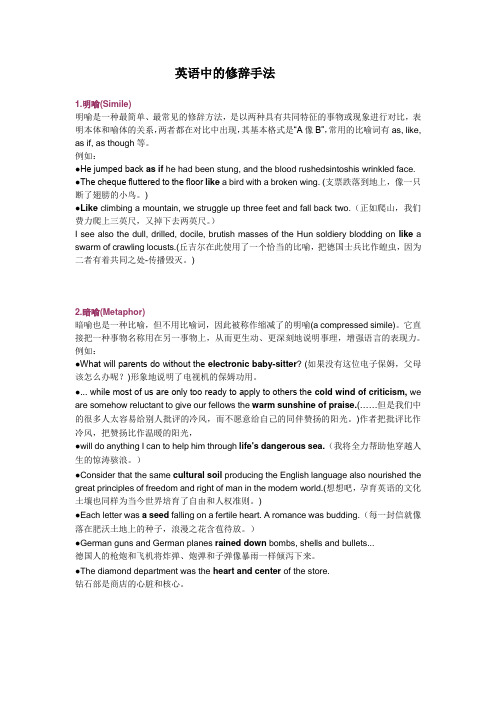
英语中的修辞手法1.明喻(Simile)明喻是一种最简单、最常见的修辞方法,是以两种具有共同特征的事物或现象进行对比,表明本体和喻体的关系,两者都在对比中出现,其基本格式是“A像B”,常用的比喻词有as, like, as if, as though等。
例如:●He jumped back as if he had been stung, and the blood rushedsintoshis wrinkled face.●The cheque fluttered to the floor like a bird with a broken wing. (支票跌落到地上,像一只断了翅膀的小鸟。
)●Like climbing a mountain, we struggle up three feet and fall back two.(正如爬山,我们费力爬上三英尺,又掉下去两英尺。
)I see also the dull, drilled, docile, brutish masses of the Hun soldiery blodding on like a swarm of crawling locusts.(丘吉尔在此使用了一个恰当的比喻,把德国士兵比作蝗虫,因为二者有着共同之处-传播毁灭。
)2.暗喻(Metaphor)暗喻也是一种比喻,但不用比喻词,因此被称作缩减了的明喻(a compressed simile)。
它直接把一种事物名称用在另一事物上,从而更生动、更深刻地说明事理,增强语言的表现力。
例如:●What will parents do without the electronic baby-sitter? (如果没有这位电子保姆,父母该怎么办呢?)形象地说明了电视机的保姆功用。
●... while most of us are only too ready to apply to others the cold wind of criticism, we are somehow reluctant to give our fellows the warm sunshine of praise.(……但是我们中的很多人太容易给别人批评的冷风,而不愿意给自己的同伴赞扬的阳光。
英文写作中的修辞手法运用

英文写作中的修辞手法运用在英文写作中,修辞手法是一种有效的表达和感染读者的方式。
通过使用修辞手法,作家可以更加生动地描述事物,增加文章的深度和吸引力。
本文将探讨一些常见的修辞手法,并举例说明其在英文写作中的应用。
1. 比喻比喻是一种通过比较两个不同的事物来形容一个事物的手法。
它能够为读者提供更直观、生动的想象,使作品更易于理解和接受。
例如,在描写悲伤时,可以使用“我的心如同一片乌云笼罩着”来强调内心的沉重和黑暗。
2. 拟人拟人是将非人事物赋予人的行为、感受和特征。
通过这种方式,读者可以更容易地与描述的事物产生情感共鸣。
例如,“大海咆哮着将浪花推向岸边”,通过赋予海洋动作和声音,使读者更好地感受到它的威力和震撼力。
3. 排比排比是将一系列相似的词语、短语或句子排列在一起,以增加表达的力度和效果。
例如,“爱,是一面永不磨灭的镜子;信任,是一座连接心灵的桥梁;希望,是一束明亮的阳光。
”通过使用排比,可以增强表达的节奏感和力量。
4. 反问反问是一种用问句表达出肯定或否定的修辞手法。
它能够引起读者的思考和共鸣,使文章更加引人入胜。
例如,“难道我们不应该珍惜自然资源吗?我们不应该为环境保护付出努力吗?”通过反问,可以强调问题的重要性和紧迫性。
5. 省略省略是在表达中有意地省略一些词语或句子,以增加表达的简洁和力度。
例如,“行百里者半九十”,通过省略“的”字,使表达更加简练,同时也更容易引起读者的共鸣和思考。
6. 夸张夸张是一种用夸大的表述语言来形容事物,以增加效果和吸引力的修辞手法。
例如,“他的胃口像一头饿得发狂的狮子”,通过夸张的语言,强调主人公的饥饿感和渴望。
在英文写作中,修辞手法是一种重要的表达方式。
通过巧妙运用比喻、拟人、排比、反问、省略和夸张等修辞手法,可以让文章更加生动、深入人心。
同时,修辞手法也需要恰当地运用,不要过度使用,以免失去原有的效果。
因此,在写作中,我们应该有意识地运用修辞手法,让我们的文章更富有色彩和吸引力。
英文文章中的修辞手法

英文文章中的修辞手法修辞手法是指在文学或修辞作品中使用的特定语言技巧或表达方式。
以下是常见的英文修辞手法:1. Metaphor: A figure of speech that compares two unlike things without using "like" or "as". For example, "The world is a stage".2. Simile: A figure of speech that compares two unlike things using "like" or "as". For example, "She is as innocent as a lamb".3. Personification: Giving human characteristics or qualities to non-human things. For example, "The wind whispered through the trees".4. Hyperbole: Exaggerating for emphasis or dramatic effect. For example, "I've told you a million times".5. Alliteration: The repetition of consonant sounds at the beginning of words in close proximity. For example, "Peter Piper picked a peck of pickled peppers".6. Onomatopoeia: The use of words that imitate or suggest the sound of what they describe. For example, "buzz", "crash", or "sizzle".7. Oxymoron: Combining two contradictory terms for a dramatic or poetic effect. For example, "bittersweet", "jumbo shrimp".8. Irony: Using words that imply the opposite of their literalmeaning, often for humorous or sarcastic effect. For example, "Sure, I'd love to work on a Saturday".9. Allusion: A reference to a well-known person, event, or work of literature. For example, "He's a real Romeo with the ladies".10. Repetition: Repeating words or phrases for emphasis. For example, "I have a dream" in Martin Luther King Jr.'s famous speech.These are just a few examples of the many rhetorical devices used in English literature and writing. The use of these techniques can enhance the beauty, impact, and persuasive power of the language in a text.。
英文写作技巧有效应用修辞和修辞手法
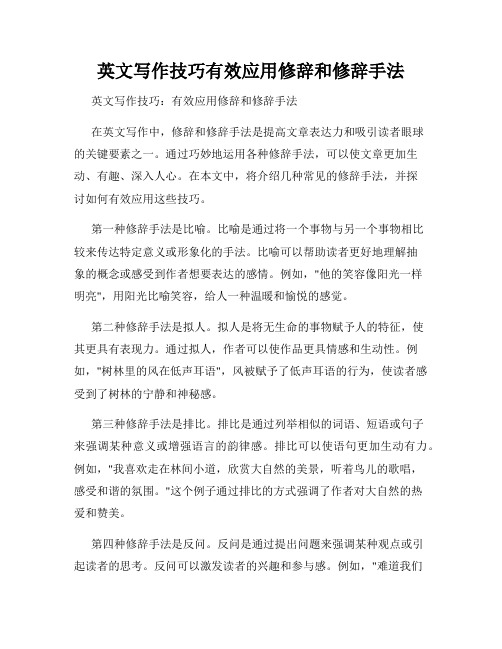
英文写作技巧有效应用修辞和修辞手法英文写作技巧:有效应用修辞和修辞手法在英文写作中,修辞和修辞手法是提高文章表达力和吸引读者眼球的关键要素之一。
通过巧妙地运用各种修辞手法,可以使文章更加生动、有趣、深入人心。
在本文中,将介绍几种常见的修辞手法,并探讨如何有效应用这些技巧。
第一种修辞手法是比喻。
比喻是通过将一个事物与另一个事物相比较来传达特定意义或形象化的手法。
比喻可以帮助读者更好地理解抽象的概念或感受到作者想要表达的感情。
例如,"他的笑容像阳光一样明亮",用阳光比喻笑容,给人一种温暖和愉悦的感觉。
第二种修辞手法是拟人。
拟人是将无生命的事物赋予人的特征,使其更具有表现力。
通过拟人,作者可以使作品更具情感和生动性。
例如,"树林里的风在低声耳语",风被赋予了低声耳语的行为,使读者感受到了树林的宁静和神秘感。
第三种修辞手法是排比。
排比是通过列举相似的词语、短语或句子来强调某种意义或增强语言的韵律感。
排比可以使语句更加生动有力。
例如,"我喜欢走在林间小道,欣赏大自然的美景,听着鸟儿的歌唱,感受和谐的氛围。
"这个例子通过排比的方式强调了作者对大自然的热爱和赞美。
第四种修辞手法是反问。
反问是通过提出问题来强调某种观点或引起读者的思考。
反问可以激发读者的兴趣和参与感。
例如,"难道我们不应该保护环境,让我们的子孙后代能够生活在一个美丽的世界里吗?"通过反问,作者提出了一个引人深思的问题,引发读者对环境保护的思考。
第五种修辞手法是夸张。
夸张是通过夸大事物的特征或形容词,以引起强烈的感情反应。
夸张可以使文章更加引人注目和幽默有趣。
例如,"他是个狮子般勇敢的男子",通过夸张的说法,给人一种强烈的形象感。
通过运用这些修辞手法,我们可以让文章更加生动、有趣、深入人心。
然而,要注意适度使用修辞手法,过度运用可能会使文章显得夸张或太过花哨。
外语文学作品翻译中的修辞手法如何恰当运用
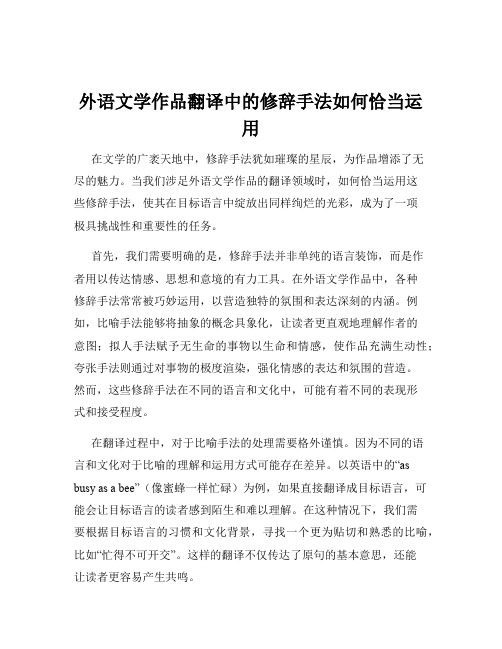
外语文学作品翻译中的修辞手法如何恰当运用在文学的广袤天地中,修辞手法犹如璀璨的星辰,为作品增添了无尽的魅力。
当我们涉足外语文学作品的翻译领域时,如何恰当运用这些修辞手法,使其在目标语言中绽放出同样绚烂的光彩,成为了一项极具挑战性和重要性的任务。
首先,我们需要明确的是,修辞手法并非单纯的语言装饰,而是作者用以传达情感、思想和意境的有力工具。
在外语文学作品中,各种修辞手法常常被巧妙运用,以营造独特的氛围和表达深刻的内涵。
例如,比喻手法能够将抽象的概念具象化,让读者更直观地理解作者的意图;拟人手法赋予无生命的事物以生命和情感,使作品充满生动性;夸张手法则通过对事物的极度渲染,强化情感的表达和氛围的营造。
然而,这些修辞手法在不同的语言和文化中,可能有着不同的表现形式和接受程度。
在翻译过程中,对于比喻手法的处理需要格外谨慎。
因为不同的语言和文化对于比喻的理解和运用方式可能存在差异。
以英语中的“as busy as a bee”(像蜜蜂一样忙碌)为例,如果直接翻译成目标语言,可能会让目标语言的读者感到陌生和难以理解。
在这种情况下,我们需要根据目标语言的习惯和文化背景,寻找一个更为贴切和熟悉的比喻,比如“忙得不可开交”。
这样的翻译不仅传达了原句的基本意思,还能让读者更容易产生共鸣。
拟人手法的翻译也需要充分考虑文化和语言的差异。
比如,在外语文学作品中,可能会将大自然拟人化为一位温柔的母亲。
在翻译成中文时,我们需要思考中文读者对于大自然的拟人化想象是否与原文一致。
如果不一致,就需要进行适当的调整,以确保读者能够准确地理解作者想要表达的情感和意境。
夸张手法在翻译时同样需要小心把握。
有些外语文学作品中可能会使用极度夸张的手法来表达强烈的情感,但这种夸张在目标语言中可能会显得过于夸张而失去真实性。
因此,翻译时需要对夸张的程度进行适度的调整,使其既能够传达出原作者的情感强度,又不会让目标语言的读者觉得不可信。
除了上述常见的修辞手法,象征手法在外语文学作品中也经常出现。
英语语言文学的常见修辞手法的应用

英语语言文学的常见修辞手法的应用
1. 比喻:将两种事物进行比较,以强调它们的相似之处,例如:时间如流水般匆匆。
2. 拟人:将非人物赋予人的特质,如“风”“呼啸着”,“大地”“颤抖着”。
3. 重复:重复同一个词或短语以加强语感和表现力,例如:天上的星星闪闪发光。
4. 排比:使用同样结构的短语或句子进行排列,例如:早上起床,刷牙洗脸,吃
早餐。
5. 倍音:在一个词或短语中,将相同或相似的音节重复使用,例如:咯咯笑声。
6. 借代:用一个代词或符号代替一个事物或概念,例如:万紫千红的鲜花,寓意
春天的到来。
7. 夸张:夸大事物的程度,使语言更加生动有趣,例如:我饿得能吞下一头牛。
8. 反问:用一个与答案相当明显的问题来掩饰自己的意图,例如:“难道不应该
付出努力吗?”
这些修辞手法可以使文学语言更富有感染力,生动独特,在英语文学中被广泛运用。
英语文学作品中修辞手法的应用探析-精选教育文档

英语文学作品中修辞手法的应用探析作者通过对语言、文字的精心构思创造出一篇篇优秀的文学作品,将自己的思想观念及时代生活背景在文学作品中展现出来,同时通过对修辞手法的运用,使文学作品依托于生活又高于生活。
文学作品中蕴含的文化气息和底蕴刺激读者的阅读感官,为其带来良好的阅读感受。
想成为一个成功的作家,首先要对文学写作手法特别熟练,并能将自己的写作风格进行完美的融合,创造出自己风格的文学作品。
文学作品所运用的修辞风格是根据作者的不同而变化的,但是不管哪种风格都对作品的成功发挥较大的作用。
本文对英语文学作品中的修辞手法进行描述分析,再分别列举比喻、幽默和矛盾三种修辞手法的应用。
一、英语文学作品中常用的修辞手法(一)拟人修辞Personification在中文中被翻译为“拟人”,其字面意思就可以很好地对这种修辞手法作出解释:将没有生命特征的物体或者是自然界的生物当作人类进行描写,赋予它们“人类”的行为动作、语文特征及情感,从而使原本没有生命特征的物体或自然界生物变得生动形象,使读者在阅读作品的时候对所描绘的对象更加印象深刻。
例如:The front garden was a gravel square;four evergreen shrubs stood at each corner,where they struggled to survive the dust,and fume from a busy mainroad.(前庭是一个被铺满沙粒的四方形,其四周都种有一丛常青灌木,他们常年忍受着从繁忙街道上吹来的尘烟,坚强地生存下来。
)这句话中作者使用了拟人手法对常青灌木的生存情况进行描绘,从侧面突出“我”前往求职的学校环境状况相当糟糕。
(二)移就修辞移就(Transferred epithet)修辞也常常被应用于文学作品中,其作用是将描写事物A的词语或者段落用于事物B的描述,用于描写事物B本身的词语或段落存在着很大的别扭。
英语文学作品中的修辞赏析[权威资料]
![英语文学作品中的修辞赏析[权威资料]](https://img.taocdn.com/s3/m/00cdaf667ed5360cba1aa8114431b90d6c8589d2.png)
英语文学作品中的修辞赏析摘要:纵观中外文学的作品中,无一例外的都有或多或少的修辞手法应用。
把比喻、拟题、夸张、排比等修辞手法应用到文学作品中,可以让人物或者事物更加生动形象,惟妙惟肖,让读者流连忘返,为文章增加更多动人色彩。
本文就英语文学作品中的比喻、拟人和夸张修辞手法做一个简要的赏析。
关键词:英语文学修辞赏析每一部文学作品的产生,都是集齐作者的生活经历、感悟为一体,加上一些言语表达技巧而成,它不仅仅反映这社会的真实状态,同时也在抒发作者的情感。
每一位成功的文学家抑或是作家,都有自己独特的语言文字表达方式。
他们风格各异,在修辞格的运用上面也各有千秋,不同的修辞格在不同作家的笔下,给读者带来的文学感受也是不同的。
修辞格的使用在各大文学作品中都会出现,了解修辞格,可以更好地赏析文学作品的内涵。
比喻就是把两个不同事物的相似之处进行比较,使得其中一个事物更加鲜活。
文学作品中加入比喻的修辞手法可使文章更加生动形象,文章的可读性也得到了大大的加强,绝大部分的文学作品中都会使用这种修辞手法,它们颇受作家的钟爱。
比喻可以分为明喻、暗喻。
明喻在英语文学作品中的运用和我国汉语的用法大致是相同的,有本体和喻体,通过对两个事物的特征或者形态进行对比,从而得出本体与喻体之间的相似之处。
英语文学作品中,通常会用一些列如“like”“as if”“such as”等的标志词。
伟大文学家莎翁《十四行诗》一文中有这样一句话:“ So are you to my thoughts as food tolife .”文意为:“你对我的思想就像食物对于生命一样重要。
”莎翁把人与人的相思之情和食物对于人的生命作比较,生动形象地表达了他的爱之切,用情至深。
另一种是文中并不出现“like”“such as”这样的象征词。
如wrence作品中一句:“with the quickness of a long cat,she climbed up into the nest of cool-bladed foliage.”暗喻即隐喻。
英文写作中的修辞手法应用
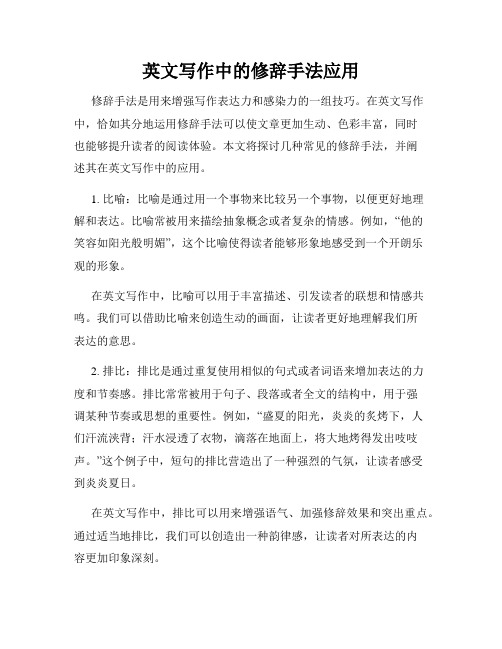
英文写作中的修辞手法应用修辞手法是用来增强写作表达力和感染力的一组技巧。
在英文写作中,恰如其分地运用修辞手法可以使文章更加生动、色彩丰富,同时也能够提升读者的阅读体验。
本文将探讨几种常见的修辞手法,并阐述其在英文写作中的应用。
1. 比喻:比喻是通过用一个事物来比较另一个事物,以便更好地理解和表达。
比喻常被用来描绘抽象概念或者复杂的情感。
例如,“他的笑容如阳光般明媚”,这个比喻使得读者能够形象地感受到一个开朗乐观的形象。
在英文写作中,比喻可以用于丰富描述、引发读者的联想和情感共鸣。
我们可以借助比喻来创造生动的画面,让读者更好地理解我们所表达的意思。
2. 排比:排比是通过重复使用相似的句式或者词语来增加表达的力度和节奏感。
排比常常被用于句子、段落或者全文的结构中,用于强调某种节奏或思想的重要性。
例如,“盛夏的阳光,炎炎的炙烤下,人们汗流浃背;汗水浸透了衣物,滴落在地面上,将大地烤得发出吱吱声。
”这个例子中,短句的排比营造出了一种强烈的气氛,让读者感受到炎炎夏日。
在英文写作中,排比可以用来增强语气、加强修辞效果和突出重点。
通过适当地排比,我们可以创造出一种韵律感,让读者对所表达的内容更加印象深刻。
3. 比较:比较是将两个事物进行对比,以帮助读者更好地理解和感受。
比较可以用在单个句子、段落或者整篇文章中,在不同层面上进行对比。
例如,“学习如同爬山,需要坚定的意志和持久的努力。
而成功则如同登顶,需要攀爬、冒险和克服困难。
”比较在英文写作中有多种应用方式,可以用来解释复杂的概念、构建对立的观点或者展示出某种变化。
通过巧妙地比较,我们可以为读者提供更加具体和清晰的视角。
4. 反问:反问是一种修辞手法,通过提出疑问但不期望得到肯定或否定的回答,以引发读者的思考和共鸣。
例如,“难道我们不应该关注自然环境的保护吗?”这个反问句向读者传递了一种呼吁和意识提醒。
反问在英文写作中常被用来引起读者的思考、强调某种观点或者加强语气。
(完整word版)英语修辞手法总结,推荐文档

英语修辞手法总结Figures of speech (修辞)are ways of making our language figurative. When we use words in other than their ordinary or literal sense to lend force to an idea, to heighten effect, or to create suggestive imagery, we are said to be speaking or writing figuratively. Now we are going to talk about some common forms of figures of speech.1) Simile:(明喻)It is a figure of speech which makes a comparison between two unlike elements having at least one quality or characteristic (特性)in common. To make the comparison, words like as, as...as, as if and like are used to transfer the quality we associate with one to the other. For example, As cold waters to a thirsty soul, so is good news from a far country.2) Metaphor:(暗喻)It is like a simile, also makes a comparison between two unlike elements, but unlike a simile, this comparison is implied rather than stated. For example, the world is a stage.3) Analogy: (类比)It is also a form of comparison, but unlike simile or metaphor which usually uses comparison on one point of resemblance, analogy draws a parallel between two unlike things that have several common qualities or points of resemblance.4) Personification: (拟人)It gives human form of feelings to animals, or life and personal attributes(赋予) to inanimate(无生命的) objects, or to ideas and abstractions(抽象). For example, the wind whistled through the trees.5) Hyperbole: (夸张): It is the deliberate use of overstatement or exaggeration to achieve emphasis. For instance, he almost died laughing.6) Understatement: (含蓄陈述)It is the opposite of hyperbole, or overstatement. It achieves its effect of emphasizing a fact by deliberately(故意地) understating it, impressing the listener or the reader more by what is merely implied or left unsaid than by bare statement. For instance, It is no laughing matter.7) Euphemism: (委婉)It is the substitution of an agreeable or inoffensive(无冒犯) expression for one that may offend or suggest something unpleasant. For instance, we refer to "die" as” pass away".8) Metonymy (转喻)It is a figure of speech that has to do with the substitution of the mane of one thing for that of another. For instance, the pen (words) is mightier than the sword (forces).9) Synecdoche (提喻)It is involves the substitution of the part for the whole, or the whole for the part. For instance, they say there's bread and work for all. She was dressed in silks.10) Antonomasia (换喻)It has also to do with substitution. It is not often mentioned now, though it is still in frequent use. For example, Solomon for a wise man. Daniel for a wise and fair judge. Judas for a traitor.11) Pun: (双关语)It is a play on words, or rather a play on the form and meaning of words. For instance, a cannon-ball took off his legs, so he laid down his arms. (Here "arms" has two meanings: a person's body; weapons carried by a soldier.)12) Solipsism: (一语双叙)It has two connotations. In the first case, it is a figure by which a word, or a particular form or inflection of a word, refers to two or more words in the same sentence, while properly applying to or agreeing with only on of them in grammar or syntax(句法). For example, He addressed you and me, and desired us to follow him. (Here we are used to refer to you and me.)In the second case, it a word may refer to two or more words in the same sentence. For example, while he was fighting, and losing limb and mind, and dying, others stayed behind to pursue education and career. (Here to losing one's limbs in literal; to lose one's mind is figurative, and means to go mad.)13) Zeugma: (轭式搭配)It is a single word which is made to modify or to govern two or more words in the same sentence, wither properly applying in sense to only one of them, or applying to them in different senses. For example, the sun shall not burn you by day or the moon by night. (Here noon is not strong enough to burn)14) Irony: (反语)It is a figure of speech that achieves emphasis by saying the opposite of what is meant, the intended meaning of the words being the opposite of their usual sense. For instance, we are lucky, what you said makes me feel real good. 15) Innuendo: (暗讽)It is a mild form of irony, hinting in a rather roundabout (曲折)way at something disparaging(不一致) or uncomplimentary(不赞美) to the person or subject mentioned. For example, the weatherman said it would be worm. He must take his readings in a bathroom.16) Sarcasm: (讽刺)It Sarcasm is a strong form of irony. It attacks in a taunting and bitter manner, and its aim is to disparage, ridicule and wound the feelings of the subject attacked. For example, laws are like cobwebs, which may catch small flies, but let wasps break through.17) Paradox: (似非而是的隽语)It is a figure of speech consisting of a statement or proposition which on the face of it seems self-contradictory, absurd or contrary toestablished fact or practice, but which onfurther thinking and study may prove to be true, well-founded, and even to contain a succinct point. For example more haste, less speed.18) Oxymoron: (矛盾修饰)It is a compressed paradox, formed by the conjoining(结合) of two contrasting, contradictory or incongruous(不协调) terms as in bitter-sweet memories, orderly chaos(混乱) and proud humility(侮辱).19) Antithesis: (对照)It is the deliberate arrangement of contrasting words or ideas in balanced structural forms to achieve emphasis. For example, speech is silver; silence is golden.20) Epigram: (警句)It states a simple truth pithily(有利地) and pungently(强烈地). It is usually terse and arouses interest and surprise by its deep insight into certain aspects of human behavior or feeling. For instance, Few, save the poor, feel for the poor.21) Climax: (渐进)It is derived from the Greek word for "ladder" and implies the progression of thought at a uniform or almost uniform rate of significance or intensity, like the steps of a ladder ascending evenly. For example, I came, I saw, I conquered.22) Anti-climax or bathos: (突降) It is the opposite of Climax. It involves stating one's thoughts in a descending order of significance or intensity, from strong to weak, from weighty to light or frivolous. For instance, But thousands die, without or this or that, die, and endow(赋予) a college, or a cat.23) Apostrophe:(顿呼)In this figure of speech, a thing, place, idea or person (dead or absent) is addressed as if present, listening and understanding what is being said.For instance, England! awake! awake! awake!24) Transferred Epithet: (转类形容词)It is a figure of speech where an epithet (an adjective or descriptive phrase) is transferred from the noun it should rightly modify(修饰) to another to which it does not really apply or belong. For instance, I spent sleepless nights on my project.25) Alliteration: (头韵)It has to do with the sound rather than the sense of words for effect. It is a device that repeats the same sound at frequent intervals(间隔) and since the sound repeated is usually the initial consonant sound, it is also called "front rhyme". For instance, the fair breeze blew, the white foam flew, the furrow followed free.26) Onomatopoeia: (拟声)It is a device that uses words which imitate the sounds made by an object (animate or inanimate), or which are associated with or suggestive(提示的) of some action or movement。
英语文学作品中修辞手法的赏析

英语文学作品中修辞手法的赏析作者:潘启玲来源:《科教导刊·电子版》2014年第23期摘要本文仅对英语文学作品中常用的比喻、幽默及矛盾三种修辞手法进行赏析,以帮助英语学习者更好地掌握这些常用修辞,学会鉴赏英语文学作品之美。
关键词英语文学修辞手法中图分类号:H319 文献标识码:A1比喻修辞手法英语文学的比喻修辞同中国文学的比喻修辞有异曲同工之妙,它是英语文学中常用的修辞手法之一。
比喻的英文为image,其来源于拉丁文,意为“影像”或“映像”。
通常是指将两个本质不同的事物以某种形式联系起来,比喻有本体和喻体,本体和喻体有某种程度的关联。
比喻修辞的困难在于找到两种事物的相似之处,从而引发读者丰富的想象,达到言有尽而意无穷的表达效果。
英语中的比喻修辞有明喻和暗喻,明喻是指本体和喻体之间有相同的特征,英语文学中的明喻随处可见,一般以as if /as thought/like等词作为标志,例如,Life be beautiful like summer flowers and death like autumn leaves(生如夏花之绚烂,死如秋叶之静美),泰戈尔的这句诗巧用比喻的修辞技法,把生的希望比作夏天绚丽的花朵,与死的静美比作秋天飘飞的落叶,将生与死的美表现得淋漓尽致。
2幽默修辞手法幽默,顾名思义是指某人的行为、举动或某事引人发笑,但却不失内涵,是一种高层次的智慧思考,幽默与一个国家的文化有着深刻的联系,不同国家对幽默的理解与感受各有不同。
要对英语文学的幽默修辞手法进行一番赏析,学习和掌握一定的西方语言文化十分必要,否则就难以对英语文学中出现的幽默修辞有很好的认知,更谈不上高层次的赏析。
幽默修辞在英语文学作品中有多种表现形式,其最常使用的是通过各种不同词格或是以文章最后的意外结局来实现幽默,这与中国文学作品的幽默方式存在一定的差异。
词格是指言语主体结合当前语境及自身目的而自觉遵守的语言使用规范。
英语中的修辞技巧与应用

英语中的修辞技巧与应用修辞技巧在英语写作中起着至关重要的作用,它能够提升文章的表达力和吸引力。
本文将介绍几种常见的英语修辞技巧,并探讨其在实际应用中的效果。
1. 比喻与拟人比喻和人物拟人是两种常见的修辞手法,它们能够通过对比和生动的形象使读者对所表达的内容产生更加深刻的印象。
例如,在描述美丽风景时,我们可以使用比喻来将其与宝石花园相媲美;在描绘动物时,可以运用拟人手法使其像人一样拥有思想和感情。
2. 排比与对偶排比和对偶是增强表达效果的修辞技巧,它们通过并列的方式使文章更加有条理和对称。
通过使用排比和对偶,作者能够将相似或对立的事物进行对比并凸显出其中的特点。
例如,“为了学习,我们需要勤奋、毅力和耐心;为了成功,我们需要智慧、勇气和机遇。
”3. 反问与修辞问句反问和修辞问句是用来引起读者思考和注意的修辞手法。
通过用问句的形式表达观点或问题,作者能够使读者主动参与到文章中,增加阅读的互动性和吸引力。
例如,“人生苦短,我们应该浪费时间吗?”4. 夸张与夸张修辞夸张和夸张修辞是运用夸张手法来强调某种观点或感受的修辞技巧。
通过夸张修辞,作者能够吸引读者的注意力,并使其更加深刻地理解表达的内容。
例如,“我等了一万年才等到这一天的到来。
”5. 比较与对比比较和对比是用来对事物进行对照和分析的修辞手法。
通过对比不同事物的特点或相似之处,作者能够更加清晰地表达自己的观点或理解。
比较和对比能够使文章更具说服力和逻辑性。
例如,“在城市生活与乡村生活之间,每个人都有自己的选择。
”6. 反复与重复反复和重复是通过多次提及同一观点或词语来加强其强调和记忆的修辞手法。
通过反复和重复,作者能够使读者更加深刻地理解和记住所表达的内容。
例如,“我们无论身在何处,无论遭遇何种困难,我们都要坚持不懈,永不放弃。
”总结起来,英语中的修辞技巧包括比喻与拟人、排比与对偶、反问与修辞问句、夸张与夸张修辞、比较与对比以及反复与重复。
这些技巧能够使文章更具表达力和吸引力,增强读者对内容的理解和记忆。
基础英语写作考试用英语写作修辞手法.docx
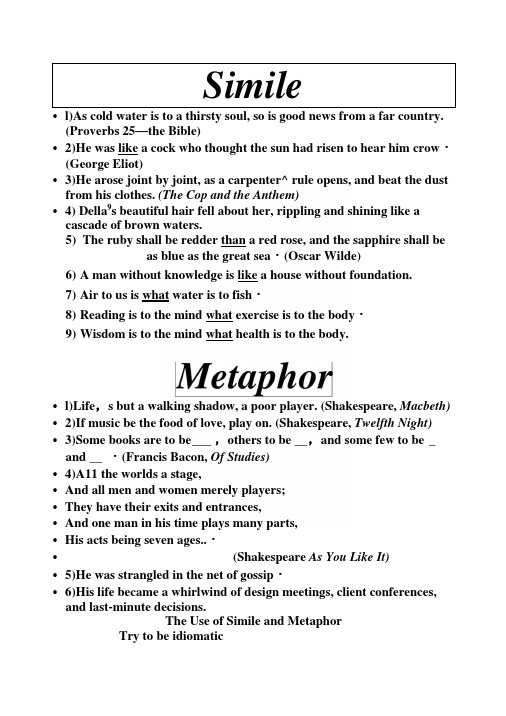
Simile•l)As cold water is to a thirsty soul, so is good news from a far country. (Proverbs 25—the Bible)•2)He was like a cock who thought the sun had risen to hear him crow・(George Eliot)•3)He arose joint by joint, as a carpenter^ rule opens, and beat the dust from his clothes. (The Cop and the Anthem)•4) Della9s beautiful hair fell about her, rippling and shining like a cascade of brown waters.5)The ruby shall be redder than a red rose, and the sapphire shall beas blue as the great sea・(Oscar Wilde)6)A man without knowledge is like a house without foundation.7)Air to us is what water is to fish・8)Reading is to the mind what exercise is to the body・9)Wisdom is to the mind what health is to the body.•l)Life,s but a walking shadow, a poor player. (Shakespeare, Macbeth)•2)If music be the food of love, play on. (Shakespeare, Twelfth Night)•3)Some books are to be ___ ,others to be __ ,and some few to be _ and __ ・(Francis Bacon, Of Studies)•4)A11 the worlds a stage,•And all men and women merely players;•They have their exits and entrances,•And one man in his time plays many parts,•His acts being seven ages..・•(Shakespeare As You Like It)•5)He was strangled in the net of gossip・•6)His life became a whirlwind of design meetings, client conferences, and last-minute decisions.The Use of Simile and MetaphorTry to be idiomaticspend money like wateras American as apple pie as strong as a horse work likehorses as stupid as a goose as dry as sawdust (wet) like adrowned rat a black sheep fish in the airPersonification•l)The ship sailed into the teeth of the hurricane・•2)The wind whistled through the trees.•The wind was moaning through the trees・•3)If not always in a hot mood to smash,the sea is always stealthily ready for a drowning・(Joseph Conrad)•4)The sky rejoices in the morning^ birth. (Wordsworth Resolution and Independence)•Examples made by some students:•5)The rose blushes in the morning breeze・•6)The leaves are trembling in the wind・•7)Please water the thirsty flowers.•8)Look at the smiling moon. How bright it is!Metonymy•Metonymy is a figure of speech which involves the substitution of the name of one thing for that of another・ In other words, it involves a “change of name”; the substituted name suggests the thing meant. •l)He must have been spoiled from the cradle・•2)You can get a good cup at Black's cafe・•3)The whole town went out to welcome him.•4) Sword and cross in hand, the European conquerors fell upon the continent of America.•5)The pen is mightier than the sword・•Grey hair should be respected・•We are reading Dickens/listening to Beethoven.•I very much like to buy an iPhone, only my purse does not allow me that luxur y・•6>He was on the bottle for 5 years.•hit the bottle•7>Her heart ruled her head.•8>Whitehall refused to confirm the reports.•9>the Pentagon•10>Oval Office; (Capitol) Hill; Madison Avenue; Fleet Street•The soldiers swore to fight for the hearth and the altar.Unchecked violence has already dulled the luster of the Big Apple. The daunting task before its leaders is to prevent it from rotting to the core・•bar•Reasons for its wide useSynecdoche •Synecdoche involves the substitution of the part for the whole, or the whole for the part・ Some experts also use synecdoche to refer to the substitution between the abstract and the concrete・•The part for the whole•l)They counted 50 sails in the harbor・•2)He paid the workers $5 per head.•3)Yet there were some stout hearts who attempted resistance・(Ceril Scott Forester)They seek office, not to be useful to the state, but for the loaves and fishes ・•The whole for the part; the material for the thing made•l)The birds sang to welcome the smiling year・•2)The doctor cut me open and took out the appendix・•3)She was dressed in silks.•4)Cotton suits you.•The abstract for the concrete•All the rank came out to see the sight.•The concrete for the abstract•She allowed the mother to be overruled by the judge and declared her own son guilty・•He has a smooth/ silver / evil/ rough/ sharp/ acid/ civil/ glib/ bitter/ bad/ wicked/ long/ oily tongue・•have/ be a big mouth• a crude-mouthed guy•sweet toothOverstatement•l)Belinda smiled, and all the world was gay. (Alexander Pope)•2)For she was beautiful—her beauty made the bright world dim,… (Percy Bysshe Shelley: The Witch of Atlas)•3)Hamlet: I loved Ophelia: forty thousand brothers could not, with all their quality of love, make up my sum・•4)You always make the same mistake. I have warned you 1000 times・•5)If s ages since we met last time.•6)No book in the world is more difficult than this linguistic book・Reading it is absolute torture・•7)After TEM4,1 could sleep for a year.•8)From his mouth flowed speech sweeter than honey・•9)1 beg a thousand pardons・•10)Polly, I love you. You are the whole world to me, and the moon and the stars and the constellations of outer space・•Thanks a million, (v)•Thanks a billion, (x)Understatement •Traditionally it is divided into litotes and meiosis.•Litotes is understatement by the use of negatives・•l)The face wasn,t a bad one; it had what they called charm. (John Galsworthy)•2)That was no mean achievement.•3)But to Darwin this was no light/ no laughing matter.•4)1 know he is no fool.•5)1 lost not a little over cards.•6)This piece of work is nothing to be proud of.•Meiosis is understatement without the use of negatives. Instead, it uses expressions like a little, a bit, kind of, sort of, almost, hardly, scarcely, etc.•l)The little boy broke a vase and was a little upset.•2)The girl is a bit slow for her age.•3)He was a little too previous in making the decision.•Irony is the use of words to mean the opposite of what they seem to mean on the surface・•l)This hard・working boy seldom reads over an hour every week・•2)It must be delightful to find oneself in a foreign country without a penny in one,s pocket.•3)Robbing an old widow of her money was certainly a noble act. •4)The child picked up the spectacles and put them on. “Now you look as wise as an owl/,said his father affectionately.Oxymoron•Oxymoron is a contradiction in terms, a compressed paradox, formed by the joining of 2 contrasting or contradictory terms.•l)The governments response to the report has been a deafening silence, •2)Barbara ― who declines interviews but is said to have loved the Barbie doll ― may be the most famous unknown figure on the planet. •3)The Poverty of Affluence: Choosing Our Success•・—When Robert Reich noticed that work was costing him his personal life, he stepped down as U・ S・ Secretary of Labor to reflect on what “success” really means.• Different forms of oxymoron:•l)adj.+n・ careful carelessness, orderly chaos,•tearful joy, honest thief, sweet torment/pain, thunderous silence, jarring concord, proud humility, luxurious poverty, noble lie, cold welcome, a generous miser, an enlightened despot•2)adj.+adj・ cold pleasant manner, poor rich guys, bitter-sweet memories, bad good news•3)ad.+adj. mercifully fatal, falsely true,•splendidly alone, disagreeably pleasant laugh•4)v.+ad・ hasten slowly, shine darkly, groan loudly•5)n.+n. a love-hate relationship■ 6)v-ing+n. a living death,loving hateEuphemism• A euphemism is a word chosen for its inoffensiveness to substitute for one considered harsh or indelicate・•stupid/mentally retarded:•He is a bit slow for his age.slow; simple; simple・minded; innocent; naive; not all there; empty・headed; one,s thick head; dull; dumb; all thumbs; underachiever •poor/penniless:•(be) hard up; in reduced circumstances; badly off; in a (bad) spot;financially challenged; the havenots; the needy; underprivileged; deprived; disadvantaged; feel the pinch•old age•old age: getting on (in years); past one,s prime; feeling one9s age; be advanced in years; an advanced age; second childhood; the veterans; elderly; golden ager; experienced; hardened; seasoned; weathered •"I respect John McCain for his half-century of service to this country. But he is on the wrong side of history right now.”•dismiss/discharge/fire•lay off; release; give/get the walking ticket; give/get the sack; sack; downsize; get a pink slip; idle; redundancy•General Electric is ready to idle 75000 according to Business Week Online. (Time^ 2001)•I regret having to make so many staff redundant.•in debt: in difficultiesdole: relief; welfare; benefit(s); entitlement•death penalty: capital punishment•lie: tell a fairy story/ tale•grave(noun)•We have come to dedicate a portion of that field as a final resting place for those who here gave their lives that that nation might live. (Abraham Lincoln, The Gettysburg Address)•The functions of euphemismAlliteration•This device is extremely popular with both poets and writers・ In this device the same consonant sound is repeated at intervals in the initial position of words.•A・ a feature of tongue-twisters•She sells sea-shells on the seashore・• A big bowl was broken by Barbara・•Round the rocks runs a river・•Down the drive dashed dashing Dan・•Peter Piper picked a peck of pickled pepper prepared by his parents and put them in a big paper plate・•B・ a rhetorical device in literature•l)And sings a solitary song,•That whistles in the wind. (Wordsworth)•2)Freedom is not given free to any who ask, liberty is not born of the Gods・ She is a child of the people, born in the very height and heat of battle …(F. Norris)•C・ in proverbial and idiomatic expressionswax and wane; think thrice and then act, look before you leap; now or never; in weal and woe; better safe than sorry; go to rack and ruin; bolt from the blue; give the devil his due; beat the band; burn one* sboat/bridges; carry coals to NewcastleWaste not, want not.Practise what you preach・Bite the bullet! The darkest hour is the nearest dawn. I bet yoiTll soon turn the tables・Sir, there is no royal road to learning・An empty sack cannot stand upright.•Proverbial and idiomatic expressions.•8) as bare as the back; as large as life; as blind as a bat; (as) bold as brass; (as) brisk as a bee; as brown as a berry; as busy as a bee; as clear as crystal; as close as a clam; (as) cool as a cucumber; as different as chalk from/ and cheese; (as) fit as a fiddle; as good as gold; as green as grass; as hungry as a hawk/ hunter; as plain as print; as pretty as picture; as proud as a peacock; as red as a rose; as right as rain; as slow as a snail; as still as a statue; as thick as thieves; as weak as water; (as) bright as a button•D・ in ads and journalistic writings•l)(Titles of articles): Bye, Bye, Balanced Budget•2) For comfort, convenience, superb service and more flights to Japan—YOU CAN DEPEND ON US. Cathay Pacific•3) Over the years, Koreans relationships with America have long seesawed between peace and peril・Jhe Times)•Application•She,s determined to win, by fair means or foul.•by hook or by crook•You shall judge a man by his foes as well as by his friends.(Joseph Conrad)• Above all, from trivial things to life philosophy, friends indisputably play an important role in influencing young adults* So it is critical for young adults to find true friends who will stand by them rain OF shine. —0402邵艳萍^Allusion•Allusion is reference to well-known persons, things, or events that the writer thinks are familiar to his readers・•Chief sources of English allusion: nursery rhymes, fairy tales, folk tales, legends, Greek and Roman mythology, Bible stories, parables, and the works of great writers•The House of the Seven Gables (Nathaniel Hawthorne)•Absalom, Absalom! (William Faulkner)•That expectation could prove the Achilles,heel of the project.(The Economist)•I learned a great many new words that day. I do not remember what they all were; but I do know that mother^ father^ sister^ teacher were among them ・・・ words that were to make the world blossom for me, “like Aaron's rod, with flowers.”(Helen Keller, The Most Important Day in MyTransfeired epithet• A transferred epithet is, as its name implies, a figure of speech where an adjective or descriptive phrase is transferred from the noun it should rightly modify to another which it does not really belong to. •Roosevelt listened with bright-eyed smiling attention・•Point out the transferred epithets in the following sentences・Though Hilary Clinton was frequently dogged by troubles for years, she always puts on a brave face in public・•She has very expensive taste(s) in clothes.•Hans shrugged his scornful shoulders.Throughout his trial he maintained a digniHed silence.•He is not an easy poet・•Application•It was the end of my exhausting first day as tutor・•(0304 Yu Cui) Tears quietly rolled down my cold face, only to leave two sad trails・•When I was in difficulties: she gave me an assuring /a reassuring hand ・•Try to interpret the following expressions which consist of transferred epithet ・•purposeless days; a murderous knife; angry fist; an understanding smile; a sympathetic look; nervous hours; sleepless/ restless nights; cold shoulder; a sleepless bed•transferred epithet: association of contiguity•personification/metaphor/simile: association of similarity •metonymy/synecdoche: association of relatedness synesthesia vs. transferred epithetTransference/empathy vs. transferred epithet。
英语文学作品中修辞手法的应用探析-文档资料
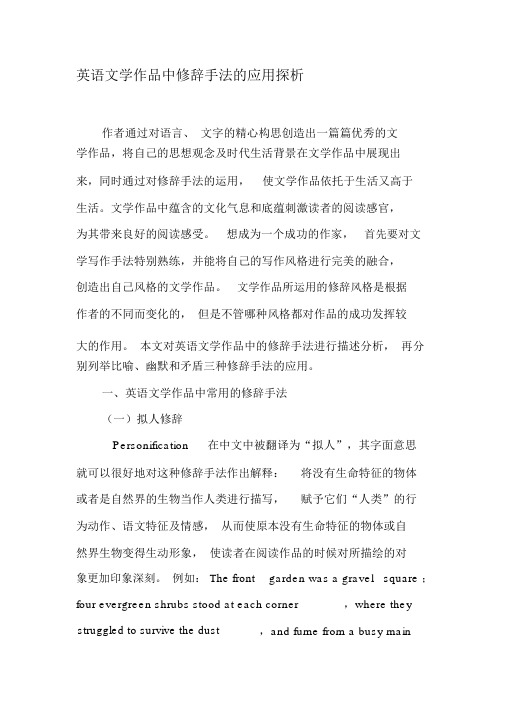
英语文学作品中修辞手法的应用探析作者通过对语言、文字的精心构思创造出一篇篇优秀的文学作品,将自己的思想观念及时代生活背景在文学作品中展现出来,同时通过对修辞手法的运用,使文学作品依托于生活又高于生活。
文学作品中蕴含的文化气息和底蕴刺激读者的阅读感官,为其带来良好的阅读感受。
想成为一个成功的作家,首先要对文学写作手法特别熟练,并能将自己的写作风格进行完美的融合,创造出自己风格的文学作品。
文学作品所运用的修辞风格是根据作者的不同而变化的,但是不管哪种风格都对作品的成功发挥较大的作用。
本文对英语文学作品中的修辞手法进行描述分析,再分别列举比喻、幽默和矛盾三种修辞手法的应用。
一、英语文学作品中常用的修辞手法(一)拟人修辞Personification在中文中被翻译为“拟人”,其字面意思就可以很好地对这种修辞手法作出解释:将没有生命特征的物体或者是自然界的生物当作人类进行描写,赋予它们“人类”的行为动作、语文特征及情感,从而使原本没有生命特征的物体或自然界生物变得生动形象,使读者在阅读作品的时候对所描绘的对象更加印象深刻。
例如: The front garden was a gravel square ;four evergreen shrubs stood at each corner,where they struggled to survive the dust,and fume from a busy mainroad. (前庭是一个被铺满沙粒的四方形,其四周都种有一丛常青灌木,他们常年忍受着从繁忙街道上吹来的尘烟,坚强地生存下来。
)这句话中作者使用了拟人手法对常青灌木的生存情况进行描绘,从侧面突出“我”前往求职的学校环境状况相当糟糕。
(二)移就修辞移就( Transferred epithet)修辞也常常被应用于文学作品中,其作用是将描写事物A的词语或者段落用于事物B的描述,用于描写事物 B 本身的词语或段落存在着很大的别扭。
英语写作中的修辞手法运用

英语写作中的修辞手法运用在英语写作中,巧妙地运用修辞手法可以使文章更加生动、形象、富有感染力,从而有效地吸引读者的注意力,增强文章的表达效果。
修辞手法就像是写作中的魔法棒,能够将平凡的文字点化成璀璨的宝石,让读者沉浸在文字所营造的美妙世界中。
比喻(Metaphor)是英语写作中常见且非常实用的一种修辞手法。
它通过将一个事物直接比作另一个事物,来更清晰地描绘出事物的特征或传达某种情感。
比如说,“Time is a thief”(时间是个小偷),将时间比作小偷,形象地表达出时间在不知不觉中偷走我们的青春和机会。
再比如,“Her smile is a sunny day”(她的微笑如晴天),用晴天来比喻她的微笑,让人能立刻感受到那笑容的温暖和明亮。
拟人(Personification)则赋予非人类的事物以人类的特征和行为,让它们变得更加鲜活和亲切。
例如,“The wind whispers through the trees”(风在树林中低语),风本是没有生命的自然现象,但通过“低语”这个人类的行为,让读者仿佛能听到风的声音,感受到风的温柔。
又如,“The stars are twinkling eyes in the sky”(星星是天空中闪烁的眼睛),把星星比作眼睛,使星空变得更加生动有趣。
夸张(Hyperbole)通过夸大或缩小事物的特征、数量、程度等来增强表达的效果,给读者留下深刻的印象。
“I'm so hungry that I could eata horse”(我饿得能吃下一匹马),显然人不可能吃下一匹马,但这种夸张的表达突出了极度的饥饿感。
“She's as thin as a toothpick”(她瘦得像根牙签),用“牙签”来夸张地形容她的瘦,让读者一下子就明白了她的身材状况。
排比(Parallelism)通过将结构相似、语气一致、意思相关的词组或句子排列起来,增强语言的节奏感和气势。
- 1、下载文档前请自行甄别文档内容的完整性,平台不提供额外的编辑、内容补充、找答案等附加服务。
- 2、"仅部分预览"的文档,不可在线预览部分如存在完整性等问题,可反馈申请退款(可完整预览的文档不适用该条件!)。
- 3、如文档侵犯您的权益,请联系客服反馈,我们会尽快为您处理(人工客服工作时间:9:00-18:30)。
英语文学作品中的修辞手法运用一部优秀和广为流传的英语文学作品,在修辞手法的运用上,作者必然是经过精雕细琢的。
纵观西方文学作品的发展历程,其文学作品的来源是现实的社会,同时也比现实社会水平高,其中的差别就在于文字之间修辞手法衬托效果的加强,例如经常见的比喻和拟人等,在能够充分体现特定历史时期社会现实问题的同时,把目光着重放在修辞手法的选择使用上,不同风格采取不同修辞手法使得作品文字表现更加灵活和生动形象,不呆板也不陈旧,其蕴含极高的艺术气息,能够让读者产生耳目一新的直观感受,对文学作品赏析以及流传具有加强的推动作用。
一、比喻修辞手法的运用
比喻在英语的文学作品中,是经常能够看到的,用得也比较多。
把两个不同性质事物的相似点加以描述是这种修辞手法运用的艺术表现形式,对原本的事物特征的描写会更加生动,比喻修辞手法有四种,包括明喻、暗喻和借喻以及提喻,本文只要分析前两种常见的使用。
提到明喻,西方英语文学作品中的明喻使用与国内汉语文学作品大致相同,是一种比较基本的比喻手法,都是通过对两种不同类型的事物以及现象的相同之处加以文学性的描述,极力突出喻体与本体之间的相通处。
在英语文学作品中一般使用Like、asif、asthough等词汇来进行明喻,西方文艺复兴时期,文学大咖把明喻修辞手法运用到了极致,就像莎士比亚的一些作品中,会这样写:“你和我之间的思念就像是食物对生命一样的”,把两人之间的思念与食物对于生命的
重要性加以比照,鲜明表达出作者内心愁苦的真实情感以及对亲友的思念之浓,引起读者内心的共鸣,加强读者对作者情感的体会。
暗喻相对于明喻来说,层次感更强而且所表达的情感要更强烈。
暗喻手法并不是用一些比喻性的词语来写的,是把这个东西当成另外一件东西来写,一般只会出现喻体而本体并没有直接显现出来,暗喻适合用于深厚情感的比喻,感情色彩较为丰富与浓厚,耐人寻味的文学表达能够勾起读者对作品的无限思考与遐想。
就像伟大诗人雪莱所提到正待觉醒的奴隶就像沉睡的雄狮一般,此作品是鼓励与推动奴隶制度的经典作品之一,奴隶与雄狮,觉醒与沉睡两者的相互对照,加强了被压迫阶级对自由,对民主的渴望,其中的鼓励作用坚定了奴隶阶级推翻上层阶级统治,推翻奴隶制度,寻求自由平等的信念。
二、象征修辞手法的运用
象征修辞手法在英语诗歌、小说以及散文中的运用较多,通过对现实社会中某些事物和现象的表达,间接传达出作者写作意图以及中心思想。
就像《荒原》这部文学作品,作者是英国著名诗人艾略特,作品中对很多典故、语言、神话等有着很大篇幅的描述,看似与社会现实联系不大,但作者所描绘的其实是象征该历史阶段现实社会真实形象,把资产剥削阶级丑恶面孔与野蛮、寸草不生的荒原进行对比,在书中对资产阶级所作所为只字不提,但对腐败资产阶级的批判充满字里行间。
作品第一部分就使用了大量的象征修辞手法,其中对荒原树木、石头、生物以及村庄等事物的描述,采用了大量阴暗和消极的词汇,勾勒出一幅万物凋零、在荒原中谋求生存极其困难的画面。
实
则是对战后现实社会的真实侧面描写,如:战争对国家城市的摧毁使得经济发展受阻,现实社会处于混乱与失控状态;人民生活失去信仰,缺少对美好生活的向往与追求,死气弥漫着整个社会等,作者描绘了一幅幅萧条落寞景象,向世人展示了战争对人类社会的破坏性,极力讽刺了资产阶级社会的丑陋与不堪。
三、拟人修辞手法的运用
拟人的修辞手法其实就是把人的形象特征用没有生命的事物以及自然事物来加以描述,把人的神态、语言或者情感附加到这些事物中,不用死板地书写人的真实情感,而是把这些复杂的高手用完全不具备生命特征以及人类情感的事物表达出来,使得这些事物更加生动形象,让读者对于作者所描绘的事物有着更加深刻的认识,使得读者产生身临其境的感觉,从而增强读者的认知度与理解度。
拟人修辞手法的使用在英语文学作品中具有把所描写事物形象化的作用,让事物更加生动而且具有活力,也能够方便读者对作者思想的理解。
拟人是一种浪漫文学艺术形式的重要组成部分,比如“黑夜轻轻将她的手放在我发烧的额头上”这一句话就具体表示了拟人手法的实际运用,将黑夜女性化,赋予了黑夜人性共有的关怀与温暖,使得黑夜充满了奇异的色彩,充满着浪漫与温情。
在另一方面也可以看出作者内心极其孤独,只有黑夜能够与他孤寂的心灵相互陪伴,侧面凸显处作者对亲友陪伴的渴望以及现实与理想之间的冲突,让读者对作者真实情感的感受与理解更加清晰,与读者产生思想与情感共鸣。
四、反语修辞手法的运用。
